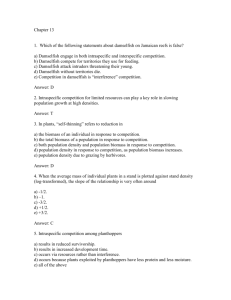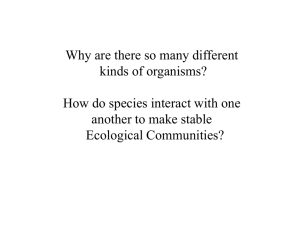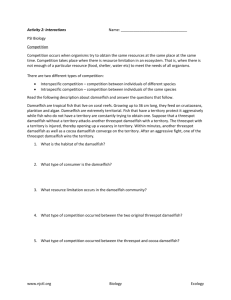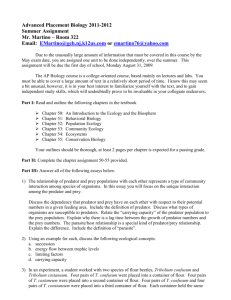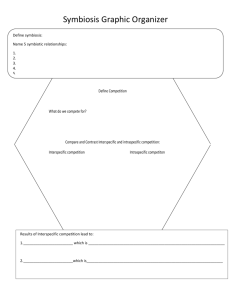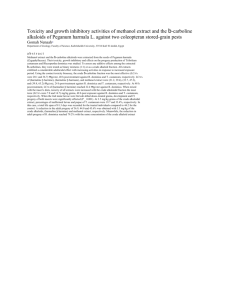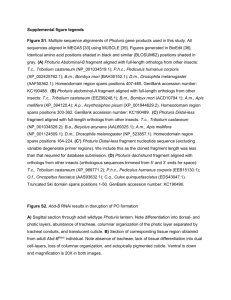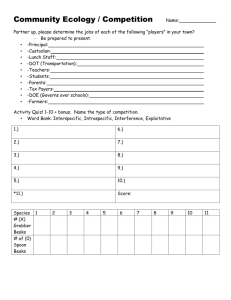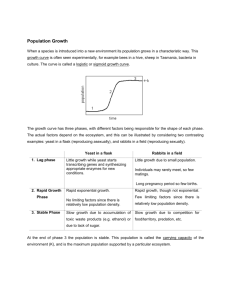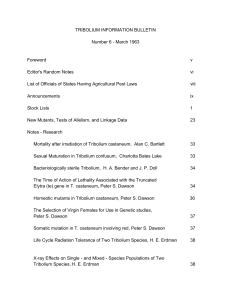Competition and coexistence
advertisement
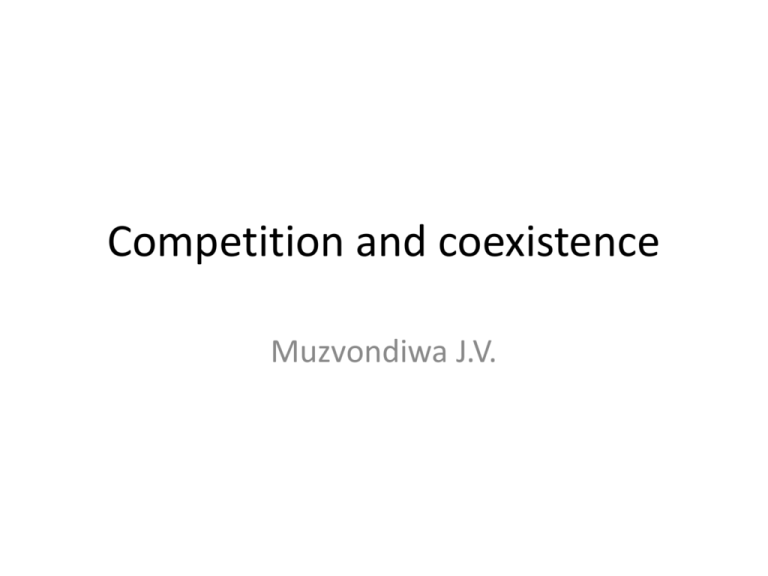
Competition and coexistence Muzvondiwa J.V. Intoduction • Competition in nature takes a number of forms. Intraspecific competition is competition within the same species, and interspecific competition is competition between different species. • Intraspecific competition is common in nature and in plants is often described by a 3/2 thinning law. Introduction • Interspecific competition is also common, and laboratory experiments have shown how outcomes can be changed by variations in the physical environment or by the presence of other species, such as parasites or predators, that affect one species, but not the other. • Competition exists among about 55% to 75% of species and the most common mechanism, is over use of the same resource. Introduction • Mathematical models called Lotka–Volterra models predict four outcomes of competition: One species is eliminated, the other is eliminated, both species coexist, or either species is eliminated, depending on starting conditions. • Competing species can sometimes coexist if they partition resources between them. Species Interactions Name of Interaction Species 1 Species 2 Mutualism + + Commensalism + 0 Herbivory + - Predation + - Parasitism - - Allelopathy - 0 Competition - - + = positive effect; 0 = no effect; - = deleterious effect Summary of biotic interactions • Herbivory, predation, parasitism – Positive for one population – Negative for the other population • Amensalism – One-sided competition – One species has a negative effect on another, but the reverse is not true. • Neutralism – Coexistence of noninteracting species – Probably rare Summary of biotic interactions • Mutualism and commensalism – – – – – Less common Symbiotic relationships Species are intimately associated with one another Both species may NOT benefit from relationship Not harmful, as is the case with parasitism • Competition – Negative effect for both species Types of competition • Interspecific – Competition between two or more different species • Intraspecific – Competition between members of the same species Characterizing competition • Resource competition (scramble competition) Occurs when a number of organisms utlize common resources that are in short supply Organisms compete for a limiting resource Plants (light, nutrients, water and pollinators) Animals (water, food, mates, space e.g space for nesting in birds and sites that are safe from predators) Characterizing competition • Interference competition (contest) Occurs when the organisms seeking a resource harm one another in the process even if resource is not in short supply Individuals harm one another directly by physical force Intraspecific Competition • Quantifying competition in plants vs. animals • • • • For plants, expressed as change in biomass For animals, expressed as change in numbers Plants cannot escape competition Animals can move away from competition • Yoda (1963) – Quantify competition between plants – Yoda’s Law or self-thinning rule; 3/2 power rule – Describes the increase in biomass of individual plants as the number of plant competitors decrease. – Log w = -3/2 (log N) + log c » w = mean plant weight » N = plant density » c = constant – w = cN3/2 Interspecific Competition • Park (1948) explored interspecies competition using two floor beetle • Variable studied in this early work were, – Constant • Climate • Initial density • Food – Varied • Volume of flour • Presence or absence of Adelina, a sporozoan parasite Park’s experiment, 1948 Park’s findings • Space did not affect greatly the pattern of growth or the outcome of competition between these two species • Cultivated together, T. confusum won over T. castaneum (66 of 74 times) regardless of the amount of space in the culture. • Cultures were infested with a parasite Adelina • T. confusum won 89% of the time • Without the parasite, no clear winner Findings Findings • Adelina was found to have an important effect on T. castaneum but not on T. confusum as indicated in Fig 13.11 above • Mean densities of larvae, pupae and adults (number per gram of flour) Density (no. /g flour) T. confusum T. castaneum With Adelina 19.2 13.3 Withoput Adelina 18.9 33.5 Experiment • Park varied the climate • Constant (Space, initial density, food, absence of Adelina) • Six combinations of temperature and humidity were investigated and the following generalised results were obtained Experiment varying climate Temp Relative Climate Humidity (%) Single species numbers Mixed species (% wins) 34 70 Hot-moist Confusum=castaneum 0 100 34 30 Hot-dry Confusum>castaneum 90 10 29 70 Temperate – moist Confusum<castaneum 14 86 29 30 Temperatedry Confusum>castaneum 87 13 24 70 Cold-moist Confusum<castaneum 71 29 24 30 Cold-dry Confusum>castaneum 100 0 T. confusum T. castaneum Findings-Microclimate effects • T. confusum did better in dry environments • T. castaneum did better in moist environments What is the mechanisms of this competition? Adult and larval Tribolium cannibalize their own eggs and pupae. This cannibalistic predation is a complex process and is responsible for most of the mortality of these flour beetles (park et al., 1965) T. Castaneum is more calibalistic than T. Confusum in general. The competition between these beetles is not over food but a special form of mutual predation Experiment varying genetics of populations • Parks also varied the genetics of population • Constant (space, initial density,food, climate, absence of adelina) • Used 8 genetic strains as indicated Experiment Findings Findings • Strains varied greatly in their competitive ability • Strain T. castaneum determined the outcome • E.g strin cl of T. castaneum always wins and strain of clII always loses Conclusion • Outcome of competition is affected both by extrinsic agencies like weather and parasites and by extrinsic properties like the genetic composition of the competing populations
